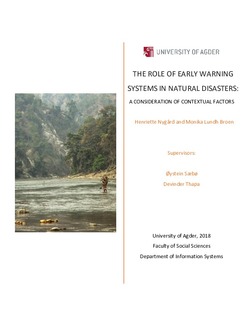| dc.description.abstract | To use an information system in the event of crisis caught our interest as it gave us the opportunity to deliver a thesis that crosses both technological and social aspects. The use of early warning systems to disseminate warnings of danger has been adapted worldwide to assist in the event of natural disasters. Through this research, the use of early warning systems in the event of extreme floods have been explored. Further, how contextual factors influence the locals’ perception of warnings presented by the early warning system was identified. To research this two research questions were defined: How do flood early warning systems operate in Nepalese context? and How do contextual factors influence the locals’ perception in relation to warning messages presented by the early warning system?
Our literature review evaluates related literature and relevant concepts for this study. The terms of natural disasters, disaster management and early warning systems are explained. Prior literature further unveils the adaption of the cycle for early warning systems to be present in Nepal. This cycle initiates four stages necessary for the disaster management to successfully perform the early warning system. The essential concepts of this study are then presented to display the relationship between them and present our area of interest.
For our thesis, the research approach used is an exploratory case study. The reason for choosing this approach is related to our journey to Nepal for exploring the early warning system implemented. Prior to our trip, the lack of related research reinforced our decision of an explorable research approach. The case is then described with a presentation of our research area in Kankai River and the focus of flood disasters which occur annually. The process of data collection is divided into three semi-structured interviews. The first is with national authorities, the second with local authorities and the main focus of interviews is with locals. Through our data analysis, two tools were used for assistance. NVivo was used to understand the use of the early warning system and to categorize and identify contextual factors influencing the locals’ perception. The Ishikawa diagram was used to display the contextual factors effect on the locals’ perception of warnings sent by the early warning system.
In our findings, the use of the cycle for early warning systems is explored. All four stages are presented through how the system is implemented and operated in Kankai River. Primarily, our study has addressed the stages of the EWS cycle and how it is used, in addition to identify the involvement of non-governmental organizations, national and local authorities. Our findings of contextual factors are secondly elaborated through how the locals explained their experience with the system. 23 contextual factors were identified and evaluated to be concerned within six categories; cultural, human capacities, physical, political, social and technical. The contextual factors were then illustrated in the Ishikawa diagram to display the causes and effects. The causes were discovered to be the contextual factors identified and the effect is the locals’ perception of warning messages. The factors found to be the most interesting and important were highlighted and elaborated. To contribute to the cycle of early warning systems, the identified contextual factors were situated into the four stages.
v
Our discussion elaborates how the interesting and important contextual factors are presented in relation to prior literature. Most of the contextual factors were determined to be supported by prior literature, while a few of the factors contradicts prior literature. The remaining interesting or important contextual factors adds to existing literature through new or unique perspectives. Our discussion further seeks to contribute to practice with increased knowledge of how the early warning system is operated and with a focus on the locals’ perspective. We have discussed the locals’ perspective through how increased consideration of their opinions can improve the implementation of early warning systems. Suggestions for future research are given to further ensure importance of our findings with additional case studies and use of theoretical perspectives. Our recommendation is to apply the theory of affordance to our findings to understand the contextual factors to a wider extent. In addition, the limitations of our study are presented to be influenced by language complications and time constraints.
In conclusion, our study of how the cycle of early warning systems is applied in Kankai River is useful for practice. Other areas implementing a flood early warning system is better equipped as they know the arrangements of the stages prior to implementation. The actors involved have been addressed through our findings, and this is useful information for implementing EWS in rural areas. Additionally, considering contextual factors when implementing and operating their system will be beneficial. Through including the locals’ perspectives, the transition is considered to be less challenging. The influences identified can therefore enlighten disaster management in further implementation of EWS. | nb_NO |

